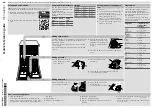
3
1.
Prepare and Load the Dishwasher
IMPORTANT: Remove leftover food, bones, toothpicks and other hard
items from dishes. Remove labels from containers before washing.
■
Make sure when dishwasher door is closed no items are blocking
detergent dispenser.
■
Items should be loaded with soiled surfaces facing down and
inward to the spray as shown in the graphics above. This will
improve cleaning and drying results. Angle dirtiest dish surface
downward, allowing space for water to flow up through rack and
between dishes.
■
Avoid overlapping items like bowls or plates that may trap food.
■
Place plastics, small plates and glasses in upper rack.
■
Wash only items marked “dishwasher safe.”
■
To avoid thumping/clattering noises during operation: Load dishes
so they do not touch one another. Make sure lightweight load items
are secured in racks.
■
Use slots in the
covers (if provided)
and suggested
loading patterns to
keep your
silverware
separated for
optimum wash.
2.
Check That All Arms Spin Freely
3.
Add Detergent
■
Use automatic dishwasher detergent only. Add powder, liquid or
tablet detergent just before starting a cycle.
■
Fresh automatic
dishwasher detergent
results in better cleaning.
Store tightly closed
detergent container in a
cool, dry place.
Premeasured Detergents
Many detergents now come in
premeasured forms (gel packs,
tablets, or powder packs).
These forms are suitable for all hardness and soil levels. Always place
premeasured detergents in main compartment and close lid.
Using dishwasher detergent tablets and packs have been proven better
than powder, liquid or gel detergents at reducing filming on dishes.
Using tablets and packs over time will start to reduce or eliminate white
film. Also, by using a rinse aid you can minimize repeat buildup of white
film.
Powder and Gels
■
The amount of detergent to use depends on:
How much soil remains on the items - Heavily soiled loads require
more detergent.
The hardness of the water - If you use too little detergent in hard
water, dishes won't be clean. If you use too much in soft water,
glassware will etch.
Soft to Medium Water (0-6 grains per U.S. gallon) [typical water
softener water and some city water]
Medium to Hard Water (7-12 grains per U.S. gallon) [well water
and some city water]
■
Depending on your water hardness, fill the Main Wash section of
the dispenser as shown. Fill the Pre-Wash section to the level
shown, if needed.
NOTE: Follow instructions on the package when using other
dishwasher detergent types.
4.
Select a Cycle (cycles vary by model)
Efficient dishwashers run longer to save water and energy, just as
driving a car slower saves on gas. Typical cycle time is approximately
2
¹⁄₂
hours, but can take less or more time to complete depending on
selections.
5.
Select Options (options vary by model)
You can customize your cycles by pressing the options desired. If you
change your mind, press the option again to turn off the option. Not all
options are available for every cycle. If an invalid option is selected for a
given cycle, the lights will flash.
OPERATING YOUR DISHWASHER
Upper rack
Lower rack
■
When loading silverware, always place sharp
items pointing down and avoid “nesting” as
shown. If your silverware does not fit into the
designated slots, flip covers up and mix
silverware types to keep them separated.


































